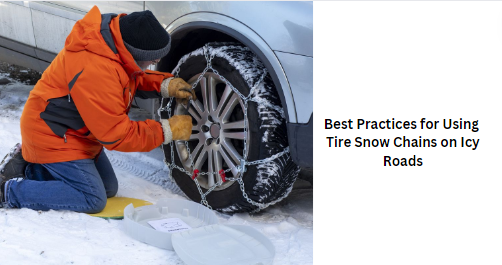
Best Practices for Using Tire Snow Chains on Icy Roads
Driving on icy roads can be treacherous, especially during the winter months. While snow tires offer improved traction, sometimes they’re not enough to navigate through thick layers of snow or ice. This is where tire snow chains come into play.
These simple yet effective devices can provide the extra grip needed to safely traverse icy roads. However, using tire snow chains requires proper knowledge and technique to ensure both effectiveness and safety.
In this blog post, we’ll discuss the best practices for using tire snow chains on icy roads, offering valuable insights to help drivers confidently navigate winter conditions.
Understanding Tire Snow Chains
Tire snow chains, also known as tire chains or snow chains, are devices fitted onto the tires of vehicles to enhance traction on snow and ice-covered roads. They consist of metal links or cables that wrap around the tire tread, providing additional grip by biting into the snow and ice.
When properly installed, snow chains significantly improve a vehicle’s ability to accelerate, brake, and steer in slippery conditions.
Best Practices for Using Tire Snow Chains
1. Choose the Right Chains:
Before purchasing tire snow chains, ensure they are the correct size for your vehicle’s tires. Refer to the owner’s manual or check with a knowledgeable retailer to determine the appropriate size and type of chains for your specific vehicle make and tire size. Using improperly sized chains can lead to reduced effectiveness and potential damage to your vehicle.
2. Practice Installation:
Familiarize yourself with the installation process of tire snow chains before hitting the road. Practice installing them in a safe and controlled environment, such as your driveway or garage, where you can take your time and troubleshoot any issues that may arise. Remember, the goal is to install the chains securely and evenly on each tire.
3. Install Chains on Drive Wheels:
Tire snow chains should typically be installed on the drive wheels of your vehicle. For most vehicles, this means installing them on the front wheels for front-wheel drive cars and on the rear wheels for rear-wheel drive vehicles. However, consult the manufacturer’s recommendations for all-wheel drive or four-wheel drive vehicles, as they may vary.
4. Follow Manufacturer Instructions:
Always follow the manufacturer’s instructions when installing tire snow chains. Each brand may have specific guidelines regarding installation, tensioning, and maintenance. Failure to adhere to these instructions could result in improper installation or damage to the chains.
5. Check Chain Tension:
After installing the tire snow chains, check the tension to ensure they are snug against the tire tread. Chains that are too loose may not provide sufficient traction, while chains that are too tight could cause damage to the tires or vehicle components. Follow the manufacturer’s recommendations for adjusting the tension as needed.
6. Drive Slowly and Cautiously:
Adjusting your driving behavior to match the road conditions is essential when driving with tire snow chains. Reduce your speed and increase following distance to allow for safe stopping distances. Accelerate, brake, and steer gently to avoid skidding or loss of control. Remember, tire chains enhance traction but do not eliminate the risks associated with icy roads.
7. Avoid Dry Pavement:
Tire snow chains are designed for use on snow and ice-covered roads. Avoid driving on dry pavement with tire chains installed, as this can cause excessive wear and damage to both the chains and tires. Remove the chains once you reach dry or cleared roads to preserve their lifespan and maintain optimal performance.
8. Regular Maintenance:
Proper maintenance of tire snow chains is essential for longevity and effectiveness. After each use, remove the chains, clean off any snow or debris, and allow them to dry thoroughly before storage. Inspect the chains for signs of wear, damage, or weakened links, and replace any worn or damaged components promptly.
9. Practice Emergency Installation:
In the event of sudden deteriorating weather conditions, having the ability to quickly install tire snow chains can be invaluable. Practice emergency installation techniques so you can efficiently install the chains when needed, even in challenging conditions such as heavy snowfall or low visibility.
10. Know When to Use Tire Chains:
Understanding when to use tire chains is crucial for safe winter driving. Tire chains should be used when driving on icy, snow-covered roads with limited traction. Check local regulations and road conditions before installing tire chains, as some areas may have specific requirements or restrictions regarding their use.
Conclusion
Tire snow chains are valuable tools for navigating icy roads safely during the winter months. By following these best practices for installation, usage, and maintenance, drivers can maximize the effectiveness of tire snow chains while minimizing the risk of accidents or damage to their vehicles.
Remember, preparation and caution are key when driving in winter conditions, so always prioritize safety when venturing out onto snowy or icy roads.
Incorporating tire snow chains into your winter driving toolkit can provide added confidence and peace of mind, knowing that you’re equipped to handle whatever Mother Nature throws your way. Stay safe, stay prepared, and happy travels!
You May Also Like

How Virtual Data Rooms Can Help with Cross -Border M&A Transactions
May 18, 2023
The Benefits of Working with a Game Art Outsourcing Studio
August 1, 2023

